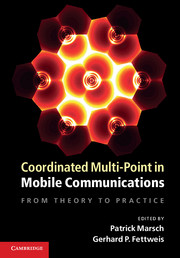Book contents
- Frontmatter
- Contents
- List of Contributors
- Acknowledgements
- List of Abbreviations
- Nomenclature and Notation
- Part I Motivation and Basics
- Part II Practical CoMP Schemes
- Part III Challenges Connected to CoMP
- 7 Clustering
- 8 Synchronization
- 9 Channel Knowledge
- 10 Efficient and Robust Algorithm Implementation
- 11 Scheduling, Signaling and Adaptive Usage of CoMP
- 12 Backhaul
- Part IV Performance Assessment
- Part V Outlook and Conclusions
- References
- Index
10 - Efficient and Robust Algorithm Implementation
from Part III - Challenges Connected to CoMP
Published online by Cambridge University Press: 05 August 2012
- Frontmatter
- Contents
- List of Contributors
- Acknowledgements
- List of Abbreviations
- Nomenclature and Notation
- Part I Motivation and Basics
- Part II Practical CoMP Schemes
- Part III Challenges Connected to CoMP
- 7 Clustering
- 8 Synchronization
- 9 Channel Knowledge
- 10 Efficient and Robust Algorithm Implementation
- 11 Scheduling, Signaling and Adaptive Usage of CoMP
- 12 Backhaul
- Part IV Performance Assessment
- Part V Outlook and Conclusions
- References
- Index
Summary
In this chapter, we now look into algorithm implementation aspects connected to CoMP. In Section 10.1, the issue of numerically robust and flexible multicell precoding is addressed, while Section 10.2 looks into the performance of interference rejection combining filters under practical conditions.
Robust and Flexible Base Station Precoding Implementation
As we have seen in Sections 6.3 and 6.4, spectral efficiency can be significantly increased if downlink CoMP schemes based on multi-cell joint signal processing are applied. Here, multiple base stations (BSs) perform a joint and coherent transmission towards multiple user equipments (UEs). Especially cell-edge users with symmetric links gain from the joint transmission (JT) with minimized inter-cell and inter-user interference compared to conventional cellular mobile networks.
In a cellular system, a spatial downlink resource allocation algorithm may switch between a single link transmission comprising one BS and one UE, a single BS multi-user scenario or finally a multi-cell joint transmission. The precoder must be able to cope with different system setups or matrix dimensions respectively. Such an implementation requires a higher signal processing flexibility as compared to non-cooperative setups. Physical link parameters like line-of-sight (LOS), non-LOS, or correlated transmit and receive antenna patterns influence the CoMP multi-user MIMO (MU-MIMO) eigenvalue spread and finally the spatial diversity and multiplexing gains.
Furthermore, in real-time hardware, the link parameters are related to finite precision effects.
- Type
- Chapter
- Information
- Coordinated Multi-Point in Mobile CommunicationsFrom Theory to Practice, pp. 219 - 242Publisher: Cambridge University PressPrint publication year: 2011



